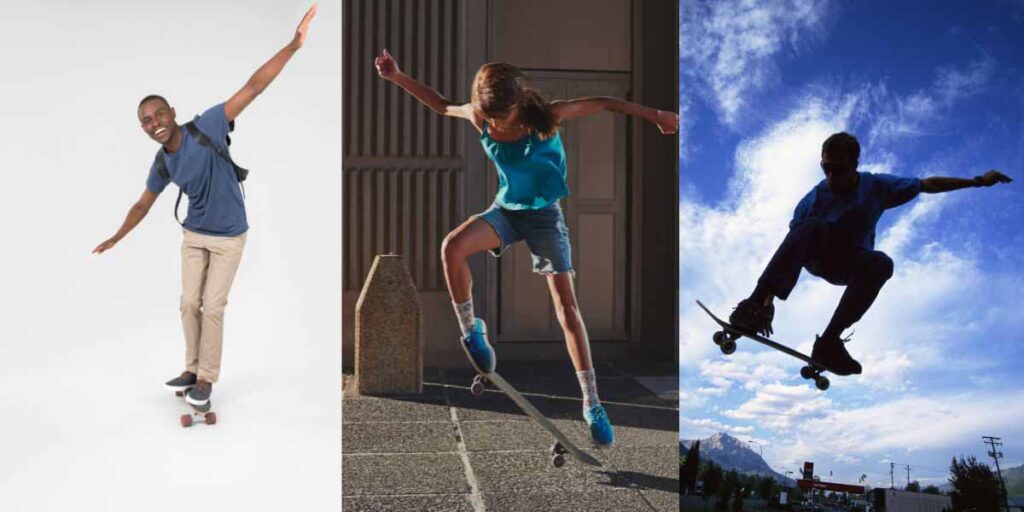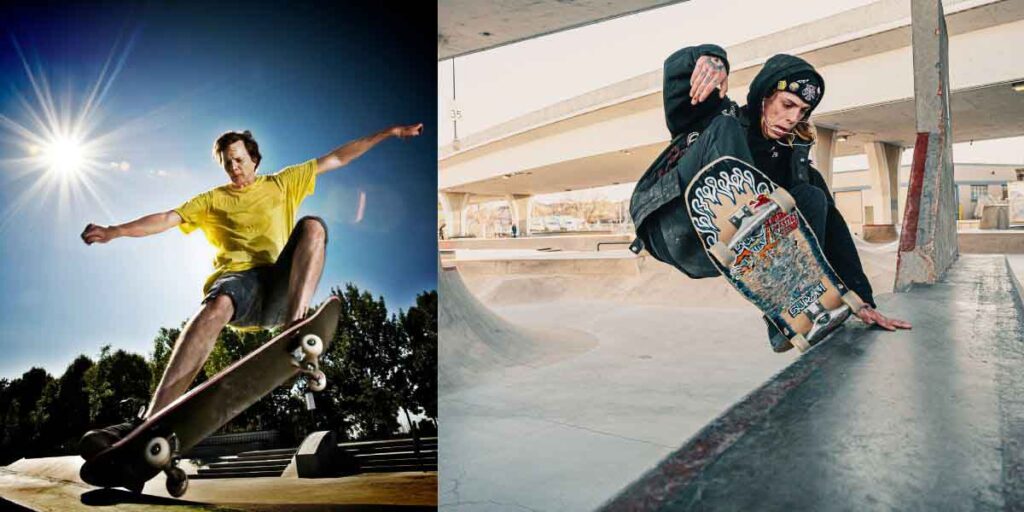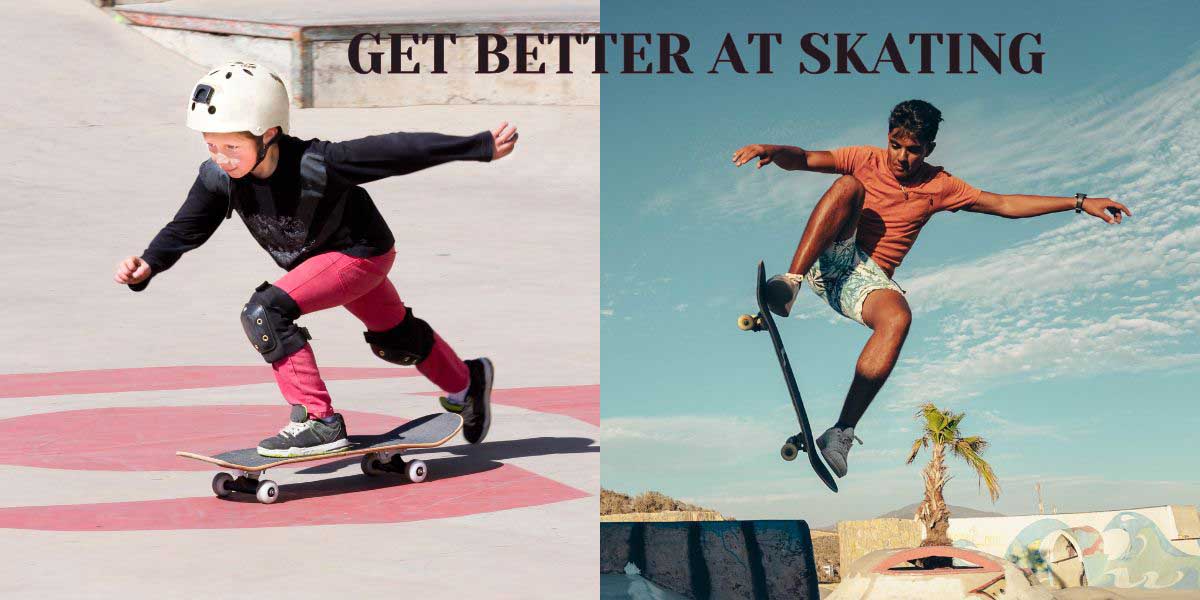Whether you’re a beginner or a pro skateboarder, there’s always room for improvement. So, how can you get better at skateboarding? To get better at skateboarding, practice regularly, master fundamental techniques, train at home, and embrace a positive mindset.
In this blog, we will discuss proven ways to develop your skateboarding game. Let’s dive in and learn how to level up your skills.
7 Tips on How to Get Better at Skateboarding

1. Practice Regularly and Consistently
Consistency is key when it comes to skateboarding. Practicing regularly helps you build muscle memory, which makes movements feel more natural over time. Even short sessions can add up, so aim to get on your board as often as possible.
Setting a routine can be incredibly beneficial; try to dedicate specific times during the week for skating, whether it’s after school, at work, or on weekends.
Start with simple tricks, gradually working your way up to more complex moves. Don’t rush the process—every small step counts towards overall improvement.
The more time you spend on your board, the more comfortable and confident you’ll become. Logging your practice sessions, even briefly noting what you worked on or how you felt, can also help you track progress and stay motivated.
2. Focus on Fundamentals Skills: Balance, Control, and Stance
Before attempting advanced tricks, it’s important to master the fundamentals like balance, control, and stance. These basics form the backbone of all skateboarding skills.
Whether you ride regularly or goofy, ensure your stance is comfortable and balanced. Practice riding in both directions to improve overall control.
Balance is key to almost every move on a skateboard. Use exercises like one-foot balances or even balance boards to fine-tune your equilibrium
Additionally, stay away from habits like Mungo pushing (pushing with your front foot) as it can lead to awkward positioning and hinder your progress. Instead, focus on proper foot positioning and pushing techniques.
Taking the time to get these basics right sets you up for success with more complex tricks down the line.
3. Go to Skateparks and Join a Community
Skateparks are a great place to learn, practice, and connect with other skaters. Spending time at a skatepark allows you to observe different techniques, styles, and tricks that you might not have thought of trying. Being around other skaters can boost your motivation and push you to challenge yourself.
Watch other skaters and take note of their movements, tricks, and styles. You can learn a lot just by observing others.
Don’t hesitate to ask experienced skateboarders for advice. Most are happy to share tips and tricks, especially if they see you putting in the effort.
Skating with others can keep your motivation high, especially on days when you’re struggling. A supportive community can make all the difference.
Being part of a skating community not only helps you improve but also makes the experience more enjoyable and fulfilling.
4. Learn from Failures: Fall Safely and Don’t Rush
Falling is an inevitable part of skateboarding. Instead of fearing it, learn to fall safely and use each fall as a learning opportunity.
Practicing safe falling techniques like rolling out of a fall or landing on your side, can significantly reduce the risk of injury. It’s also important not to rush your progress. Each trick and skill takes time to master, and pushing yourself too hard can lead to frustration or even injury.
Focus on understanding the mechanics of each move, breaking it down step by step. Remember, every fall is a chance to learn what didn’t work and make adjustments.
You can stay motivated and progress steadily by approaching failures with a positive mindset.
5. Cross-Training: Strengthen Your Body for Skateboarding
Skateboarding requires physical strength, flexibility, balance, and endurance. Incorporating cross-training exercises into your routine can significantly boost your performance.
Focus on building core strength, as a strong core enhances your balance and control. Exercises like planks, leg raises, and crunches are excellent for this.
Cardio workouts such as jogging or cycling improve your stamina, allowing you to skate longer without tiring easily. Flexibility is also key; stretching regularly can prevent injuries and help you move more fluidly on your board. Simple strength training, like squats or light weight lifting, can improve the power and precision of your tricks.
By taking care of your body off the board, you’ll be better equipped to handle the physical demands of skateboarding.

6. Set Goals and Track Your Progress
Setting specific goals is a powerful way to stay motivated and measure your improvement.
Instead of vague goals like “get better,” aim for something specific, such as “land a kickflip in two weeks.” This gives you a clear target.
Tracking your progress through a video diary, journal, or checklist allows you to see how far you’ve come and what areas still need work. Documenting your journey can also serve as a source of inspiration on tough days.
No matter how small, celebrate your successes. Landing a new trick or mastering a skill is worth recognizing.
Celebrate each milestone, no matter how small, and use these wins as fuel to keep pushing forward.
Goal-setting helps turn practice into progress and keeps your enthusiasm alive.
7. Keep a Positive Mindset and Enjoy the Journey
Skateboarding is as much about mindset as it is about skills. It’s easy to get frustrated when things don’t go as planned. But staying positive helps you overcome challenges and keeps you motivated.
Improvement can be slow, but a positive attitude helps you stay motivated. Celebrate progress, no matter how small, and keep pushing forward.
Avoid comparing yourself to others. Everyone progresses at their own pace, and your journey is unique.
Skateboarding should be fun, so make sure you’re enjoying the process. Celebrate the small victories, and laugh at the wipeouts. Always remember why you started skating in the first place.
A positive attitude will keep you engaged, inspired, and eager to push your limits.
How to Practice Skateboarding at Home?
Sometimes, getting to a skatepark isn’t feasible, but that doesn’t mean you can’t practice. Practicing at home is a convenient way to improve, especially when access to a skatepark is limited.
- Create a Safe Space: Use your garage, driveway, or a spacious room to practice. Clear away obstacles to ensure you have enough space to move freely and safely.
- Simple Home Exercises: Work on basic skills like ollies, balance drills, or foot positioning. Set up basic obstacles like homemade ramps or small rails to simulate park conditions.
- Alternative Training Methods: Balance boards and stationary practice tools can mimic the feel of skateboarding, helping you develop control and coordination without leaving the house.
Home practice allows you to work on fundamentals in a comfortable environment, setting the stage for success at the park.
FAQs on How to Get Better at Skateboarding
How often should I practice skateboarding to get better?
Practice as often as possible, even if it’s just 15-30 minutes a day. Consistency helps build muscle memory, improving your skills over time.
What are the most important skills to master in skateboarding?
Focus on balance, control, and stance. These fundamentals are the building blocks for more advanced tricks and maneuvers.
How can I stay motivated when I struggle with a trick?
Set small, achievable goals and track your progress. Celebrate each success, no matter how small, and remember that every skater progresses at their own pace.
Is it better to learn skateboarding alone or with others?
Both have benefits, but skating with others at a skatepark or community can boost your motivation and provide valuable feedback.
How can I improve my balance on a skateboard?
Practice exercises like one-foot balances or use a balance board. Regular practice will enhance your equilibrium and overall board control.
How can I avoid injuries while learning new tricks?
Take your time mastering each move, wear protective gear, and always warm up before skating. Safe falling techniques also help minimize injuries.
Conclusion
Getting better at skateboarding is a journey that involves practice, patience, and passion. Start by practicing regularly and learning the basics. Also, join a community of skaters who can support and encourage you. Stay positive and enjoy each ride, knowing you’re getting better with every session. Remember, you’re learning and growing every time you step on your board. So grab your skateboard, hit the pavement, and keep pushing forward—your best skating days are ahead of you!

